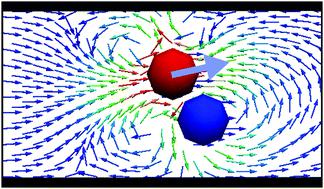当前位置:
X-MOL 学术
›
Soft Matter
›
论文详情
Our official English website, www.x-mol.net, welcomes your feedback! (Note: you will need to create a separate account there.)
Hydrodynamic collision between a microswimmer and a passive particle in a micro-channel
Soft Matter ( IF 3.4 ) Pub Date : 2021-2-10 , DOI: 10.1039/d0sm02140g Ahana Purushothaman 1, 2, 3 , Sumesh P. Thampi 1, 2, 3
Soft Matter ( IF 3.4 ) Pub Date : 2021-2-10 , DOI: 10.1039/d0sm02140g Ahana Purushothaman 1, 2, 3 , Sumesh P. Thampi 1, 2, 3
Affiliation

|
Microswimmers interacting with passive particles in confinement are common in many systems, e.g., spermatozoa encountering other cells or debris in the female reproductive tract or active particles interacting with polymers and tracers in microfluidic channels. The behaviour of such systems is driven by simultaneous, three way hydrodynamic interactions between the microswimmer, the passive particle and the microchannel walls. Therefore, in this work we investigate the hydrodynamic collision between a model microswimmer and a passive particle using three different methods: (i) the point particle approach, (ii) analytical calculations based on method of reflections, and (iii) lattice Boltzmann numerical simulations. We show that the hydrodynamic collision is essentially an asymmetric process – the trajectory of the microswimmer is altered only in an intermediate stage while the passive particle undergoes a three stage displacement with a net displacement towards or away from the microchannel walls. The path of the passive particle is a simple consequence of the velocity field generated by the swimmer: an open triangle in bulk fluid and a loop-like trajectory in confinement. We demonstrate the generality of our findings and conclude that the net displacement of the passive particle due to collision may be capitalised in order to develop applications such as size separation of colloidal particles and deposition of particles in the microchannel interiors.
中文翻译:

微通道和被动通道中的被动粒子之间的流体动力碰撞
在许多系统中,微游泳器与被动粒子的相互作用是受限的,例如,精子在雌性生殖道中遇到其他细胞或碎片,或者在微流体通道中与聚合物和示踪剂相互作用的活性颗粒。这种系统的行为是由微掠器,无源颗粒和微通道壁之间同时进行的三向流体动力相互作用所驱动的。因此,在这项工作中,我们使用三种不同的方法研究模型微掠器与被动粒子之间的水动力碰撞:(i)点粒子法,(ii)基于反射法的分析计算和(iii)格子Boltzmann数值模拟。我们证明了流体动力碰撞本质上是一个不对称过程–微掠器的轨迹仅在中间阶段发生变化,而被动粒子经历了三阶段的位移,并且朝着或远离微通道壁发生了净位移。被动粒子的路径是游泳者产生的速度场的简单结果:散装流体中的空心三角形和封闭中的环状轨迹。我们证明了我们的发现的普遍性,并得出结论认为,由于碰撞而使被动粒子的净位移可被大写,以便开发诸如胶体粒子的尺寸分离和微通道内部粒子的沉积之类的应用。被动粒子的路径是游泳者产生的速度场的简单结果:散装流体中的空心三角形和封闭中的环状轨迹。我们证明了我们的发现的普遍性,并得出结论认为,由于碰撞而使被动粒子的净位移可被大写,以便开发诸如胶体粒子的尺寸分离和微通道内部粒子的沉积之类的应用。被动粒子的路径是游泳者产生的速度场的简单结果:散装流体中的空心三角形和封闭中的环状轨迹。我们证明了我们的发现的普遍性,并得出结论认为,由于碰撞而使被动粒子的净位移可被大写,以便开发诸如胶体粒子的尺寸分离和微通道内部粒子的沉积之类的应用。
更新日期:2021-03-01
中文翻译:

微通道和被动通道中的被动粒子之间的流体动力碰撞
在许多系统中,微游泳器与被动粒子的相互作用是受限的,例如,精子在雌性生殖道中遇到其他细胞或碎片,或者在微流体通道中与聚合物和示踪剂相互作用的活性颗粒。这种系统的行为是由微掠器,无源颗粒和微通道壁之间同时进行的三向流体动力相互作用所驱动的。因此,在这项工作中,我们使用三种不同的方法研究模型微掠器与被动粒子之间的水动力碰撞:(i)点粒子法,(ii)基于反射法的分析计算和(iii)格子Boltzmann数值模拟。我们证明了流体动力碰撞本质上是一个不对称过程–微掠器的轨迹仅在中间阶段发生变化,而被动粒子经历了三阶段的位移,并且朝着或远离微通道壁发生了净位移。被动粒子的路径是游泳者产生的速度场的简单结果:散装流体中的空心三角形和封闭中的环状轨迹。我们证明了我们的发现的普遍性,并得出结论认为,由于碰撞而使被动粒子的净位移可被大写,以便开发诸如胶体粒子的尺寸分离和微通道内部粒子的沉积之类的应用。被动粒子的路径是游泳者产生的速度场的简单结果:散装流体中的空心三角形和封闭中的环状轨迹。我们证明了我们的发现的普遍性,并得出结论认为,由于碰撞而使被动粒子的净位移可被大写,以便开发诸如胶体粒子的尺寸分离和微通道内部粒子的沉积之类的应用。被动粒子的路径是游泳者产生的速度场的简单结果:散装流体中的空心三角形和封闭中的环状轨迹。我们证明了我们的发现的普遍性,并得出结论认为,由于碰撞而使被动粒子的净位移可被大写,以便开发诸如胶体粒子的尺寸分离和微通道内部粒子的沉积之类的应用。



























 京公网安备 11010802027423号
京公网安备 11010802027423号